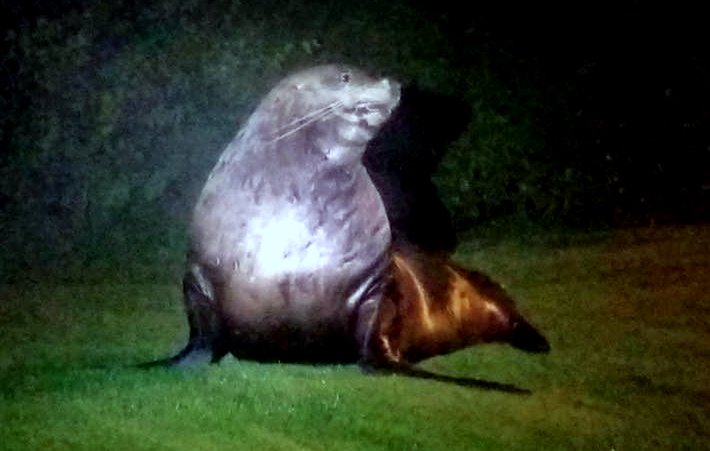
How to phone home? The Steller’s sea lion eventually took refuge in the brush off of Tongass Drive. Authorities don’t want the animal disturbed; rather, once it calms down, they believe the sea lion will return to the water. (Eric Radznuikinas photo)
UPDATED — MONDAY, SEPTEMBER 3RD
Biologists successfully returned a Steller sea lion to Sitka’s waters on Sunday, after it spent the weekend wandering down roads and into woods. Biologists with NOAA fisheries believe the adult male lost the ocean. Read the full story here.
ORIGINAL STORY – FRIDAY, AUGUST 31ST
Authorities are taking a “wait-and-see” approach with a large sea lion that was discovered early Friday morning (8-31-18) in the roadway near Mt. Edgecumbe Hospital in Sitka.
Officials with NOAA’s Marine Mammal Stranding Network believe the sub-adult male is frightened and confused, and will eventually return to the water on his own.
Here’s a short video posted to Facebook by a night-shift employee at Mt. Edgecumbe Hospital, Eric Radziukinas. Just about everyone with social media in Sitka was looking at it today. Sure, Anchorage has its share of moose in traffic, but how often do you see a sea lion lumbering down the road?
(Video by Eric Radziukinas)
While this is entertaining, it’s also a little troubling. Julie Speegle, with the National Marine Fisheries Service, says law enforcement from her agency — as well as biologists — have been monitoring the animal since the call came into police a little before 3 a.m.
“He is a sub-adult male sea lion,” said Speegle. “He was in the roadway on Tongass Drive. He appears to be frightened and confused, and he’s been sort of hiding out in the bushes a little bit. Our law enforcement officers have cordoned off the area with ribbon, and we’re asking members of the public to please avoid the area, so we can allow the animal some space and quiet to calm down.”
Although the sea lion is sub-adult, it’s no baby. Male Steller’s sea lions can grow to 1,500 pounds, and this one appears well on his way. Speegle says that a relocation plan really hasn’t been discussed yet. They’re going to try let the sea lion find his own way back — possibly with a nudge.
“At this point we are taking a wait-and-see approach,” Speegle said, “and hoping that he finds his way back to the water by himself once things calm down a little bit. There is still the possibility of using some approved hazing practices to encourage him in the right direction if the need arises.”
And if this lost sea lion does start moving again, you don’t want to be in his way. Speegle and the National Marine Fisheries Service say the best help the public can offer is to promptly report marine mammal stranding whenever you encounter one. The toll-free number for the Marine Mammal Stranding Network is 877-925-7773.






























